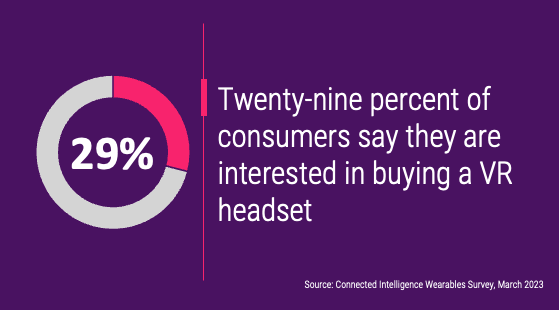
Widgets are back
Apple’s WatchOS 10 looks set to get a significant refresh, with the main upgrade being the (re)launch of widgets. These are somewhat similar to the original Glances, with a range of widgets for different apps and features, access via the crown controller. Initial widgets include stopwatches, timers and podcasts, but we expect this feature to open up a broader range of functionality as the app developers embrace it. And this is a key upgrade: while the smartwatch has long been a fitness-first device, we are seeing increased interest in other use cases beyond sports and fitness, especially as ownership reaches the 40 percent mark among US adults. To expand beyond that, all OEMs need to consider how to broaden the relevance and functionality of their smartwatches to non-fitness use cases.
That is not to say that Apple has taken its eye off the fitness focus either. The impending upgrades also include stronger functionality for cyclists, who will be able to connect their Bluetooth bike sensors and view heart rate and power data during cycling sessions. That places Garmin under more pressure, as one of the company’s key niches has been in the cycling community.
The Circana Take:
- Apple is broadening the Watch’s functionality beyond fitness and this is key. With consumer penetration close to 40 percent, the next wave of potential wearers are far less likely to buy a device for its fitness capabilities. Rather, the watch needs to be a far better extension of the smartphone for other use cases and, potentially, start to provide a stronger unique experience that allows consumers to leave their phone behind more often, which would also be great news for the carriers looking to further drive cellular watch adoption.
- Garmin’s position in the market is starting to look less secure as Apple continues to gun after the same audience, first with the launch of the Watch Ultra, and now with increased “niche” functionality such as the cycling additions.
And of course, the Vision Pro
Apple’s main headline was the launch of the Vision Pro xR headset which sets the stage for a potentially-new era of computing. Or does it? While the device is, without doubt, an extremely clever feat of engineering it is, as yet, unclear quite how well it will be adopted beyond the early adopter Apple fans. Clearly, with a price tag of $3,500 Apple’s Vision Pro is not aimed at a mainstream audience, but rather is a design statement of where Apple expects to drive the market (the key is with Apple’s use of the “Pro” moniker, leaving room for a lower-tiered device in the future). It will be a slow-burn device, with an early burst of sales to the affluent Apple fans, and then a very modest trickle of demand as more people become aware of it… if they have $3,500 to spend, of course.
The Circana Take:
- While the Vision Pro has created waves in the media, the real-world impact is far from assured. It is less the price tag that will causer issues and more the use case. Do consumers really want to be cut-off from their surroundings so obviously? Does the device actually do anything particularly unique? Yes, the interface and control aspect is brilliantly implemented (hand gestures, eye movements and so on) but the use cases demonstrated are still the usual list of watching movies, productivity and a camera.
- We’ve fielded several questions on the 5G opportunity for xR headsets (as in, is there an opportunity for a 5G version of these devices). To be clear, our answer remains a firm “no”. xR headsets remain something consumer will use in their homes (if at all, of course) and therefore there is no need for cellular connectivity. This will only change when we move away from the goggle approach towards glasses-like devices that provide an augmented-reality solution.
- In many ways, Apple’s entry into the xR market will help all other OEMs as it will drive awareness and increase the opportunity. Consumers intrigued by the concept will look for lower-priced options that may not be quite as technically brilliant but will be a fraction of the cost.